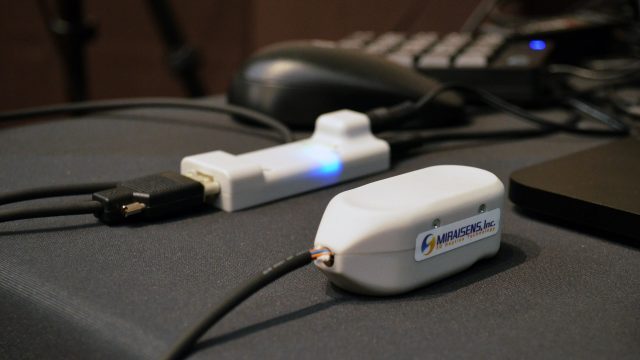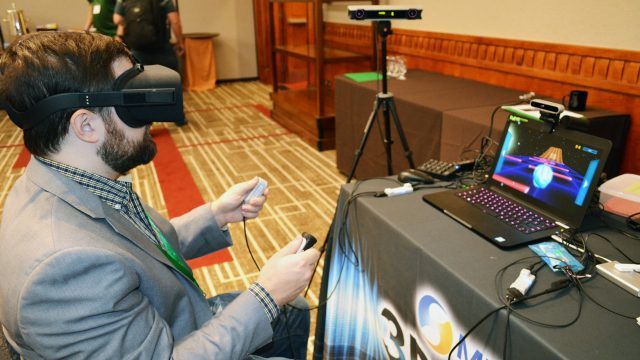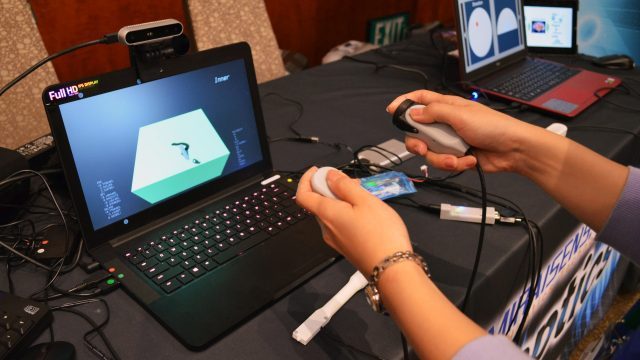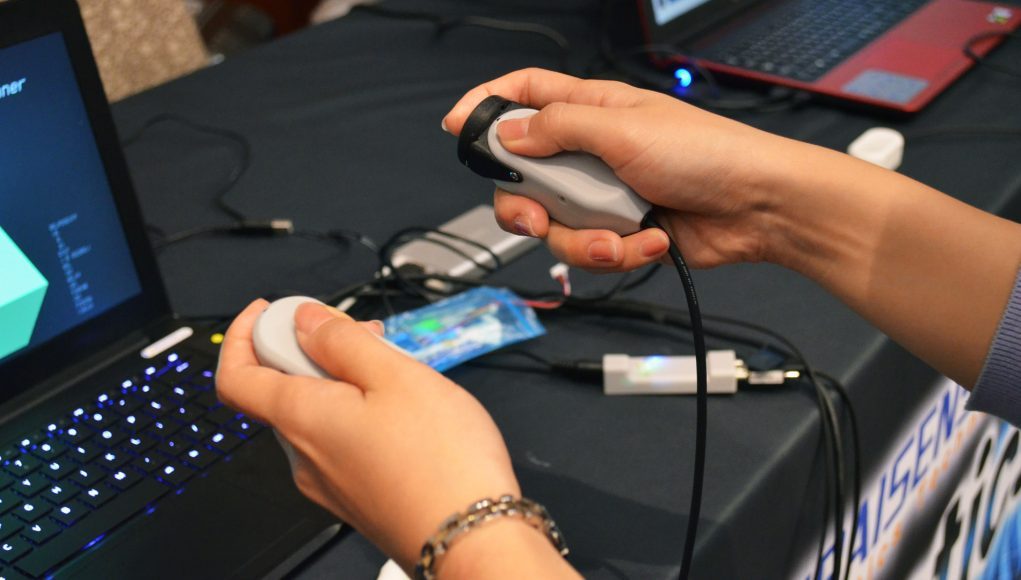MIRAISENS is Japan-based haptics company which is developing what they call 3DHaptics technology. I got a chance to try their latest demo this week at VRS 2018, which is able to achieve unique directional haptic feedback from a handheld device using relatively simple hardware.
The prototype 3DHaptics controllers from Miraisens do something that I didn’t previously think was possible. Being supported by nothing but your own hands, the unassuming prototype device uses vibrations to create sensations of an external force pushing or pulling your hand in specific directions. It isn’t a strong force, but it’s unmistakably directional. I closed my eyes and asked the demonstrator to choose random directions so I could guess the answer, and found that I was able to sense the intended direction with 100% accuracy.

The demonstrator ran me through a series of demos as I held the 3DHaptics prototype. After the simple directional demo, which allowed the demonstrator to point the device’s feedback at an arbitrary direction and amplitude, there was a series of examples using virtual springs which either asked me to compress or stretch a series of springs with one or two hands. The 3DHaptics feedback, combined with the visual feedback, was surprisingly compelling; it felt like the springs were pushing or pulling against my hands as I manipulated them. It felt almost like my hands wanted to move themselves in the implied direction.

Following the springs, I saw a series of scenes showing a marble rolling along a track. The haptics were used to convey the forces felt on the marble to me; as it wound along curves I could feel the controllers pulling in each direction. It was surprising how clear the direction was implied through the haptics, especially when the marble rolled up and down over a series of hills.
Haptics are about feedback, which means conveying useful information about something that’s happening. Accurate directional capability means that 3DHatpics can deliver information to the user which other devices cannot, which makes it particularly interesting, especially because it’s achieved with relatively simple, off the shelf hardware: linear resonance actuators (LRAs), the same haptic devices found in VR controllers like the Vive wands and Oculus Touch.
Miraisens says the secret sauce comes from the unique frequencies and waveforms with which they’re driving the LRAs. The company claims that the underlying tech is covered by several of their patents.
My understanding is that they need one LRA per directional axis, so the current two-LRA prototypes exert forces with two degrees of freedom; the company said they could achieve a third degree of translation by adding another LRA, though apparently there’s a challenge when it comes to balancing the haptics alongside weight and power consumption, as all are impacted by the number and size of LRAs used.
Because the 3DHaptics prototype uses LRAs just like existing VR controllers, the device is capable of the same simple rumbles and clicks that you feel today, in addition to the directional feedback. But it’s also able to recreate extremely detailed textural sensations (as if rubbing your hand across different textures).
Another demo I saw showed a marble which I was able to roll around on a surface by moving my hand. The controller vibrated in response to the surface texture, ranging from a coarse random pattern like small stones to a softer and more structured pattern like woven fabric. One of the surfaces had grooves in it, like the dips between concrete sidewalk segments; as I rolled the marble around I felt the fine concrete-like texture, and then a convincing bump/click sensation each time the marble crossed one of the grooves.

I was impressed with the capabilities of the 3DHaptics prototype, especially considering its size and simplicity. Miraisens told me that adding their technology to existing AR or VR controllers would add around $3 to the cost of each controller, at scale.
I was intrigued and occasionally mesmerized at what the 3DHatpics prototype was able to achieve, and asked if the team had experimented with the approach on a larger scale, like using wrist/ankle devices or even a full haptic vest. Miraisens Business Development Director Masatoshi Miyakawa told me that they hadn’t done such an experiment, and while it might be compelling, both friction and high nerve density is important for the 3DHaptics effect, and hands/fingers have a much greater density of nerves than the torso, not to mention greater friction through direct skin contact compared to the challenge of getting the haptic feeling to pass through a user’s clothes.
Speaking of nerve density, frequent high-amplitude vibrations in the hands can result in a numbing sensation; I asked if this was an issue for 3DHaptics. Miyakawa told me that their tech is not immune to this issue, and that when employing haptic feedback they need to consider the frequency of use and amplitude to ensure numbness doesn’t set in.
Miraisens, as Miyakawa explained, was founded in April 2014 and formed around research spun out of Japan’s National Institute of Advanced Industrial Science and Technology. The company has raised $7.5 million to date, and is now beginning to seek a Series B round. Miyakawa also told me that the company doesn’t have any interest in designing its own controllers, instead it wants to be a technology provider for OEMs. Miraisens has been talking to the major players in the VR field and has been refining the device based on their feedback, Miyakawa said.







